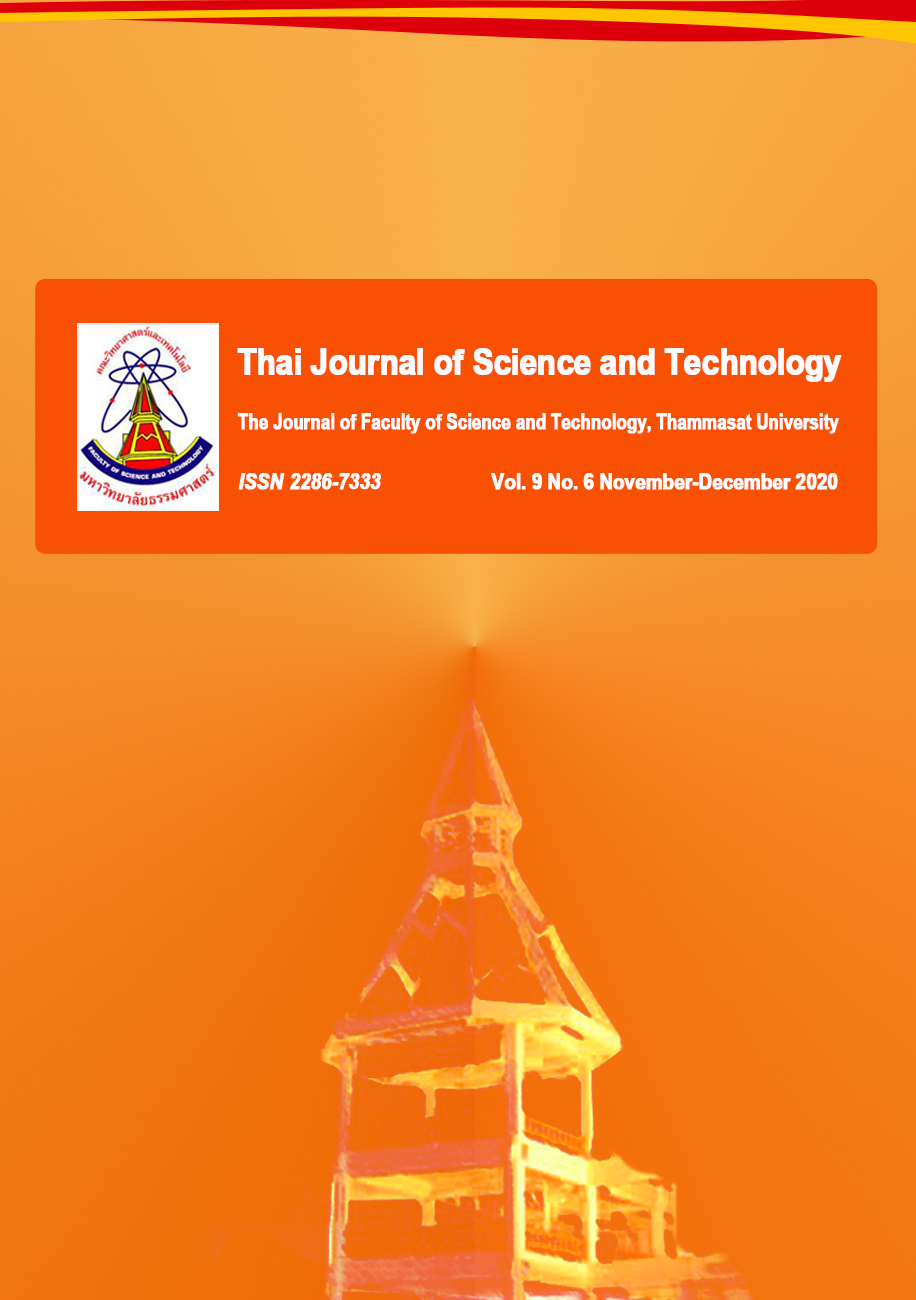Transformation of Butterfly Pea (Clitoria ternatea) F3'5'H (Flavonoid-3',5'-Hydroxylase) Gene into Patumma (Curcuma alismatifolia) ‘Blue Moon’
Main Article Content
บทคัดย่อ
Patumma (Curcuma alismatifolia) is a Zingiberaceae family with beautiful colors and needs to the market. There is one of the flower bulbs that make a high income. Patumma bulb was exported to foreign countries. When compared with the types of cut flowers and popularity, the improvement on a new appearance, value-added and competitive of Patumma, was necessary. In this research, the progress of Patumma ‘Blue Moon’ to blue shade was studied. The isolation, cloning, and characterization of flavonoid-3',5'-hydroxylase (F3'5'H) genes of butterfly pea (Clitoria ternatea), encoding an enzyme involved in the coloration of plant blue pigment, was the focus. The F3'5'H gene was isolated from butterfly pea (Clitoria ternatea and transferred to retarded shoot of Patumma ‘Blue Moon’ using Agrobacterium-mediated transformation technique. The results show that the F3'5'H genes were inserted into Patumma genome and expressed in the transcription phase. The study on Patumma ‘Blue Moon’ coloration found that transformed Patumma is bluer than non-transformed Patumma ‘Blue Moon’, but purple. All obtained results can be concluded that we successfully transformed Clitoria ternatea F3'5'H gene into Patumma and these genes could be expressed and changed the color of Patumma. Based on the findings, the knowledge to improve the color of flowers using genetic engineering is possible to be applied to improve other flowering plants to increase value and opportunity in the market.
Article Details
บทความที่ได้รับการตีพิมพ์เป็นลิขสิทธิ์ของคณะวิทยาศาสตร์และเทคโนโลยี มหาวิทยาลัยธรรมศาสตร์ ข้อความที่ปรากฏในแต่ละเรื่องของวารสารเล่มนี้เป็นเพียงความเห็นส่วนตัวของผู้เขียน ไม่มีความเกี่ยวข้องกับคณะวิทยาศาสตร์และเทคโนโลยี หรือคณาจารย์ท่านอื่นในมหาวิทยาลัยธรรมศาสตร์ ผู้เขียนต้องยืนยันว่าความรับผิดชอบต่อทุกข้อความที่นำเสนอไว้ในบทความของตน หากมีข้อผิดพลาดหรือความไม่ถูกต้องใด ๆ
เอกสารอ้างอิง
Chundet, R., U-kong, W. and Buddharak, P., 2014, Transformation of dihydroflavonal 4-reductase (DFR) gene into Patumma using Agrobacterium-mediated gene transfer, 26th Annual Meeting of the Thai Society for Biotechnology and International Conference, Mae Fah Luang University, Chiang Rai.
Murashige, T. and Skoog, F., 1962, A revised medium for rapid growth and bioassays with tobacco tissue cultures, Physiol. Plant.15: 473-497.
Nick, D.V., Jeroen, T.H., Henk-Peter, V.S., de Albertus, B., Joseph, M. and Ronald, K., 1999, A cytochrome b5 is required for full activity of flavonoid 3',5'-hydroxylase, a cytochrome P450 involved in the formation of blue flower colors, Proc Nat. Acad. Sci. USA 96: 778-783.
Kanno, Y., Noda, N., Kazuma, K., Tsugawa, H. and Suzuki, M., 2003, Transformation of Lobelia erinus, p. 121, 21st Annual Meeting of Japanese Society for Plant Cell and Molecular Biology, Kagawa.
Katsumoto, Y., Fukuchi-Mizutani, M., Fukui, Y., Brugliera, F., Holton, T.A., Karan, M., Nakamura, N., Yonekura-Sakakibara, K., Togami, J., Pigeaire, A., Tao, G., Nehra, N.S., Lu, C., Dyson, B.K., Tsuda, S., Ashikari, T., Kusumi, T., Mason, J.G. and Tanaka, Y., 2007, Engineering of the rose flavonoid biosynthetic pathway successfully generated blue-hued flowers accumulating delphinidin, Plant Cell Physiol. 48: 1589-1600.
Tanaka, Y., Katsumoto, Y., Brugliera, F. and Mason, J., 2005, Genetic engineering in floriculture, Plant Cell Tiss. Organ Cult. 80: 1-24.
Togami, J., Tamura, M., Ishiguro, K., Hirose, C., Okuhara, H., Ueyama, Y., Nakamura, N., Yonekura-Sakakibaraa, K., Fukuchi-Mizutani, M., Suzuki, K., Fukui, Y., Kusumi, T. and Tanaka, Y., 2006, Molecular characterization of the flavonoid biosynthesis of Verbena hybrida and the functional analysis of verbena and Clitoria ternatea F3'5'H genes in transgenic verbena, Plant Biotechnol. 23: 5-11.
Topoonyanont, N., Chongsang, S., Chujan, S., Somsueb, S. and Nuamjaroen, P., 2002, Micropropagation scheme of Curcuma alismatifolia Gagnep, p. 14, 2nd Agriculture of Thailand Annual Conference, Khon Khan.
U-Kong, W., Chundet, R., Thamaragsa, N., Buddharak, P. and Chandet, N., 2017, Transformation of cytochrome b5 gene into retarded shoots of potted curcuma via Agrobacterium tumefaciens, Songklanaka rin J. Plant Sci. 4(1): 31-35.
Vetten, N.D., Horst, J.T., van Schaik, H.P., de Boer, A., Mol, J. and Koes, R., 1999, A cytochrome b5 is required for full activity of flavonoid 3',5'-hydroxylase, a cytochrome P450 involved in the formation of blue flower colors, Proc. Nat. Acad. Sci. USA 96: 778-783.
Yoshida, K., Mori, M. and Kondo, T., 2009, Blue flower color development by anthocyanins: From chemical structure to cell physiology, Nat. Prod. Rep. 26: 857-964.


